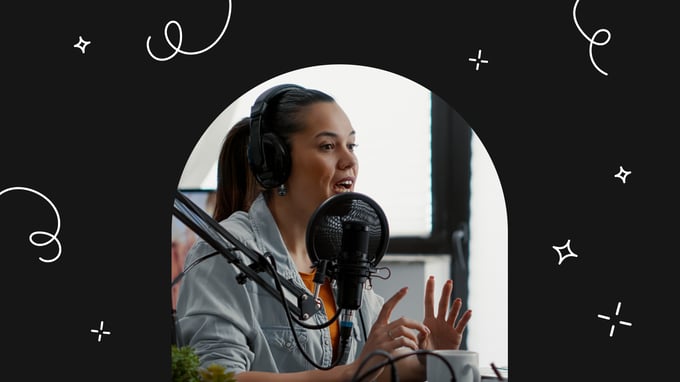Ever wonder how Searchie came to be? Lucky for you, we’re sharing our team’s insider tips to...
How To Maximize Engagement With 3 Simple Story Styles

Stories aren’t just for bedtime. They’re not just something you pull from the shelf and read to your kids at night. No way! Telling the right stories can have a massive positive impact on your online business and we’re dishing out three simple story styles to help maximize engagement with your audience.
Every single day we all communicate through stories to make a point, connect with others, and express our emotions. How many times has someone said something to you that instantly sparked a personal story? “Wow, that reminds me of…” or “Oh, remember when…”

That’s why, whatever your niche or industry, and especially if you’re looking to start a course, membership, or coaching program—you NEED to tell stories! But there’s a catch. Not all stories are created equal.
Stories that create a connection require relatability. If you’re telling a story your audience can’t relate to, you might as well be speaking in a different language.
Don’t risk listeners discounting your story because it doesn’t apply to their lives—even if your broader message does! Look at it this way, telling a story about the first time you bought a bright red, convertible sports car might not relate to everyone. But, talking about an experience with your car salesman is a broader experience that WAY more people in your audience could probably relate to, right?
That’s why to get the job done well (and maximize engagement), you’ll need relatable stories.
What kind of relatable stories, you ask? Buckle up because we’re about to dish them out!
1. First Step Stories
Getting started can be the hardest part of your audience’s journey. So inspire beginners with the stories of people who took the leap and stuck the landing!
The best “first step” stories happen when people are in the early stages of your course, membership, or coaching program. Think about anyone who hit what looked like small milestones but were actually big wins!
It always helps to put yourself in your audience’s shoes. Think about how you would feel if you were just starting out with something new. Wouldn’t you feel validated hearing stories about people like you who had similar fears, anxieties, or reservations and then went on to succeed?
New audience members can identify similar feelings and find inspiration in the victory of others starting out just like them. To maximize engagement, let your beginners know that their first big wins are within reach!
2. Mid-Journey Stories
Audiences in the middle may be feeling fatigued. They’ve done the heavy lifting of making it halfway through your program but haven’t reached a routine yet. They’re looking for people who are figuring out the transition between the beginning and the end.
For example, a mid-journey story might be about people who have seen success after implementing some of your new strategies to get even better results.
Stories from the middle of the road are inspirational to both new travelers and those already part-way through the journey.
3. Finisher Stories
Everyone wants to know what’s waiting for them at the finish line.
Of course, in the entrepreneur’s world, a membership site is never “finished” in the usual sense. Still, these stories are about people who have completed the main process and are now enjoying consistent results.
Finishers have reached one or more goals of their success path and using their stories can fabulously showcase what’s possible and help to maximize engagement. So don’t be afraid to toot the horn for the finishers in your community and spread the word of their accomplishments. Because when they look good, you do, too!
Why We All Love Stories
Why do the experiences of others connect us so deeply? Well, the best ones inspire our emotions. I’ve felt that, too! I’ve been there, too!
The key to relatability is digging through your audience’s external problems to their internal ones. This includes their feelings, fears, doubts, and dreams—these are the things that you truly need to address.
And when it comes to stories, emotions relate much more powerfully than even statistics, reports, or facts. That’s why a good story resonates so powerfully, whether from a book, a friend, or a business.
So, when picking and crafting the stories to share with your audience, the key things you want to uncover are not only what the doer has done, but the emotions they experienced at the time.
- What were they feeling?
- What were they thinking and saying?
- What were others around them thinking, feeling, and saying?
- Were there doubts, anxieties, or pain-points?
Identifying and embodying these emotions will bring your case stories to life and maximize engagement.
Thankfully, if you don’t have a stockpile of relatable stories from your own business journey, you’re not stuck in the mud. Where have you seen others succeed on a similar track?
Have you discovered examples from history, prominent figures, or other case studies that make the same point? Share their experiences!
Either way, talking about inspiring possibilities and relatable journeys makes the audience feel seen, heard, and much more open to anything you will say after.
Let audiences know you care about where they’ve been, where they are, and where they want to be. It makes all the difference.
Thanks for reading! Let us know in the comments if these storytelling tips help maximize engagement with YOUR audience!
And don’t forget to join the Searchie community Facebook Page and let us know your favorite storytelling tips!
Catch you in the next blog…
Reimagine Your Business
Create the ultimate digital content experience for your information business with Searchie Hubs. Courses, memberships, coaching programs... you name it!



